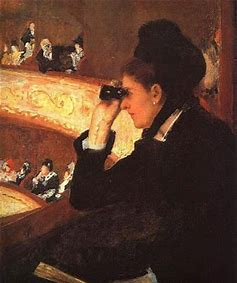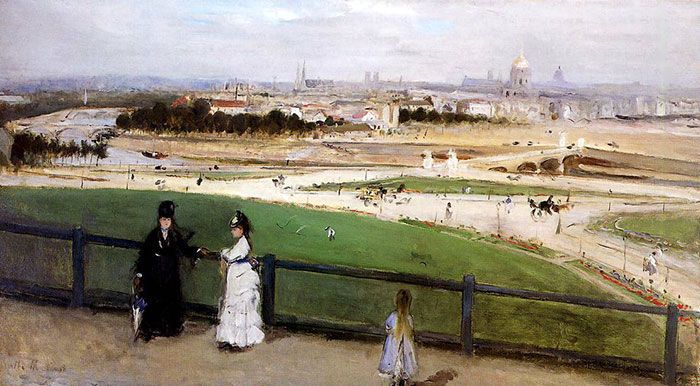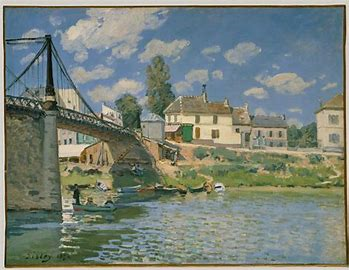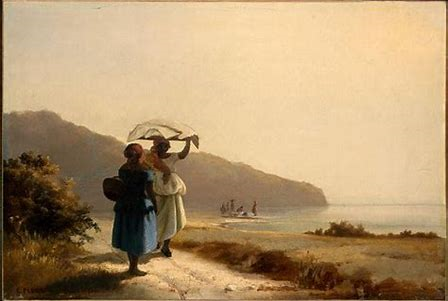Impressionism - The first distinctly modern art movement
- Nghi To

- Apr 25, 2020
- 12 min read
Updated: Oct 5, 2020
THE IDEA AND TECHNIQUE
Impressionism is the mid-19th-century art movement and can be considered the first distinctly modern movement in painting. Developing in Paris in the 1860s, its influence spread throughout Europe and then the United States. Its originators were artists who rejected the official, government-sanctioned exhibitions, and were consequently shunned by powerful academic art institutions.
In turning away from the fine finish and detail to which most artists of their day aspired, the Impressionists aimed to capture the momentary, sensory effect of a scene - the impression objects made on the eye in a few seconds. Impressionist artists loosen their brushwork and lighten their palette to light and pure colors. They abandon the clarity and linear perspective. Scientific thought at the time was beginning to recognize that what the eye perceived and what the brain understood were two different things. The Impressionists sought to capture the former - the optical effects of light - to convey the passage of time, changes in weather, and other shifts in the atmosphere in their canvases. Their art did not necessarily rely on realistic depictions.
ARTISTS & ARTWORKS
Manet
Manet is no one strange to those who love art. He was involved in Impressionism, Realism, and later, modern art. He was a French artist and became one of the first 19th-century artists to paint modern life.
The painting above, “Olympia”, depicts a woman waiting for her maid to give her the wedding dress. It is her wedding day. Purposefully provocative, it shocked the viewers of that time because it is too obscene for them. Manet rather overtly includes a black cat, symbolizing heightened sexuality and prostitution - a characteristically Baudelarian symbol.
"The Execution of Emperor Maximilian"
Manet was a devout Republican and was keenly influenced by political events, and here he sought to record contemporary events like a history painter with modern vision. The Romantic spirit and muted tones create a distinctly somber, yet immediate scene. However, the painting's subject matter was too sensitive to be exhibited at the time.
Monet
"Impression, soleil levant" (Impression, Sunrise)
The term “Impressionism” is derived from this painting of Monet’s, “Impression, soleil levant”. The painting, completed in 1872, captures a scene taking place in the early morning at a harbor in Monet’s hometown, Le Havre. Monet sought to create a scene depicting France's revitalization, the sun rising in France, its growing industry a beacon of strength and beauty.
Monet uses a number of techniques in this piece that would become signature elements of future Impressionist works. Looking closely, the heavy, discrete brush strokes are clearly visible. They are almost never blurred, but, rather, left to stand both alone and in relation to the surrounding strokes. There is an emphasis on light and its reflection upon the water and through the fog. While up close this painting appears to be a jumble of haphazard strokes, stepping back, the scene takes form in a way very reminiscent of the way it would be perceived by the eye. Monet also employs another technique utilized by the Impressionists: contrasting colors.
"The Gare St-Lazare"
This painting is regarded as one of the greatest Impressionism paintings of the 19th century. Monet’s painting, The Gare Saint-Lazare, overwhelms the viewer not though its scale (a modest 29 ½ by 41 inches), but through the deep sea of steam and smoke that envelops the canvas. The painting depicts one of the passenger platforms of the Gare Saint-Lazare, one of Paris’s largest and busiest train terminals. In fact, the painting is not a single view of a train platform but a component in a project of a dozen canvases which attempts to portray all facets of the Gare Saint-Lazare. The paintings all have similar themes—including the play of light filtered through the smoke of the train shed, the billowing clouds of steam, and the locomotives that dominate the site.
Light - the dominant formal element in so many Impressionist paintings - is given particularly close attention. Monet shows a bright day and labors to reproduce the closely observed effects of pure sunlight. The billowing clouds of steam add to the effect, creating layers of light that fill the canvas. Monet renders the steam with a range of blues, pinks, violets, tans, grays, whites, blacks, and yellows. He depicts not just the steam and light - which fill the canvas - but also their effect on the site - the large distant apartments, the Pont de l’Europe (a bridge that overlooked the train station), and the many locomotives.
"Rouen Cathedral, the West Portal and Saint-Romain Tower, Morning Fog"
Monet's persistence in painting in series, beginning with the Gare Saint-Lazare and continuing in the Poplars and Haystacks, attains an impressive climax in the series he devoted to Rouen Cathedral. Monet, it is clear, was as little concerned with the subject, masterpiece of Gothic architecture though it was, as when painting his Haystacks. Where the building invited and challenged his ability was in the fretting of the surface as it caught the light and the profound effects of shadow in the deep recesses. The heavy grain of his thick paint gave its own animation to the façade. Working largely from memory he exchanged the more fluent technique of the plein-air picture finished at a sitting for this entirely opposite quality of carefully worked-up impasto. In addition, without direct reference to the building in reality, a poetic element in his nature seems to have come uppermost. rather than conveying the atmospheric reality of sunlight, a painting such as the example given here can be appreciated as a gorgeous dream.
Degas
Edgar Degas was a French artist famous for his pastel drawings and oil paintings of ballerinas. was a member of the seminal group of Paris artists who began to exhibit together in the 1870s. He shared many of their novel techniques, was intrigued by the challenge of capturing effects of light and attracted to scenes of urban leisure. But Degas's academic training, and his own personal predilection toward Realism, set him apart from his peers, and he rejected the label 'Impressionist' preferring to describe himself as an “Independent.”
"Foyer de la Danse"
There is something unique and alluring in all of Degas's studies of ballerinas, of which there are many. In this painting, he presents us with one of the unconventional perspectives that are so typical and distinctive in his work. Rather than evoke the light and atmosphere of the scene, as some of his Impressionist peers might have done, Degas has chosen to create a striking arrangement of space, one which echoes the experiences his contemporaries might have had throughout the new modern city. To achieve this, rather than compose the figures in a more orderly and centered fashion, he has dispersed them about the canvas, leaving a chair incongruously placed in the center foreground. Instead of viewing the room as a traditional box-like container for the figures, he paints it at an angle, suggesting multiple vantage points.
“A Cotton Office in New Orleans” is the result of several individual sketches and careful attention to detail over a length of time. In the center, reading a newspaper, is Degas's brother, Rene, and in the foreground, handling a ball of cotton, is Rene's father-in-law, Michael Musson, who operated the cotton exchange. Its complex handling of deep space and multiple figures is testimony both to Degas's skill in composition, and his love of striking perspectives, something that makes his work stand out from that of many of his peers. He manages to knit together the fractured space by stretching areas of white across the center of the picture, letting our eye move from the cotton on the left, through the newspaper, to the shirt of the figure on the right.
Renoir
Of all the Impressionist artists, it is Pierre Auguste Renoir who was most interested in painting humans and studying the portrayal of human emotions. He was greatly inspired to paint figures, particularly of female figures. Much of Renoir's later paintings centered on nude, buxom women. His subject is always light-hearted; he enjoyed painting portraits that were brimming with life, sunlight, and realism.
“Dance in the country”
The painting above depicts a couple dancing under a chestnut tree: the man is Paul Lhôte, a friend of the painter, and the woman is Aline Charigot, who later became the wife of the painter. Both figures are painted life-size and occupy almost the entire painting. However, a table in the background on the right, and a hat on the ground, and a pair of faces below the level of the dance floor, can be seen. The woman who holds a fan in her right hand, displays a smiling face and looks towards the viewer.
The composition is typical of Renoir's flowing style but in contrast to his earlier works, all three of his Dance paintings have tighter compositions, and lines are used to direct the viewer's eye towards the couple at the center of the canvas. Renoir's expression of light and shadow comes together to create a warm, sensual painting. Famous for his vibrant light and saturated color, he depicts the couple in Dance in the Country intimately and honestly. Renoir suggests the details of this scene through liberally brushed touches of color, so that the couple softly fuses with one another and their surroundings
"The Large Bathers"
After 1910, Renoir returned to one of his favorite subjects – nudes on the open air – and produced several large paintings. In them, Renoir celebrated a timeless view of nature from which all reference to the contemporary world was banned. Renoir labored over this painting for a period of three years before he was satisfied with its composition. Along with at least two full-sized figure drawings of the models, Renoir also created many preparatory drawings for each of the figures before eventually putting brush to canvas. After completing "The Large Bathers", Renoir received severe criticism because of his new style. Tired and disillusioned, he never again created paintings of this caliber.
This painting depicts a scene of nude women bathing. In the foreground, two women are seated beside the water, and a third is standing in the water near them. In the background, two others are bathing. The one standing in the water in the foreground appears to be about to splash one of the women seated on the shore with water. The figures have a sculptural quality, while the landscape behind them shimmers with impressionistic light. With this new style, Renoir's intention was to reconcile the modern forms of painting with the painting traditions of the 17th and 18th centuries, particularly those of Ingres and Raphael. Renoir also admired Rubens and Titian's nude paintings, and he tried to find a compromise between the styles of these old masters and the new impressionist style. The Mediterranean landscape refers to the classical tradition of Italy and Greece, when "the earth was the paradise of the gods". "That is what I want to paint," added Renoir. This idyllic vision is emphasised by the models' sensuality, the rich colours and full forms. In short, he transfers classic ideas into modern drawing. This picture is an impressive composition of light and bright colours.
Cassatt
Mary Cassatt was an American painter and printmaker. Cassatt often created images of the social and private lives of women, with particular emphasis on the intimate bonds between mothers and children.
"Little Girl in Blue Armchair"
In this important work of her mature career, Cassatt chose to portray a young girl alone in a domestic interior. The visible brushwork and the figure's informal pose are hallmarks of Impressionism; the asymmetrical composition, raised viewpoint, shallow space, and abrupt cropping of the scene all indicate the influence of Japanese art. Cassatt also brings her own astute observations to the construction of this image. The girl, who was a child of a friend of Degas, is seated in a sprawling, unselfconscious manner that reminds the viewer of her young age.
"In the Loge"
This canvas shows a stylish woman attending a performance at Comedie-Francaise, a famous theater in Paris. The woman's profile is set off against the red velvet and gilt decoration of the box seats behind her as she raises a pair of opera glasses to her eyes. The black of her dress is echoed in the clothing of other figures in the background, including a man several boxes down who regards her through his own glasses. Cassatt has perceptively grasped the fact that the members of the well-dressed audience are putting on their own performances for one another. The main figure may be watching the stage or observing her fellow theatergoers while she herself becomes the subject of the man's gaze; meanwhile, the viewer, who is placed just beside the woman, takes in the entire scene.
Morisot
"View of Paris from the Trocadero"
When the second Impressionist exhibition opened in the spring of 1876 in Paris, one sharp-tongued critic described its participants as "five or six lunatics, one of which is a woman." The woman, of course, was Berthe Morisot, who in spite of her gender became a leading figure of the most famous artistic movement of the 19th century.
This early work is one of the few fully realized landscape works Morisot painted. Completed just after the end of the Franco-Prussian War, the work depicts a view of Paris as a city finally at peace. The three figures in the foreground are probably Morisot's sisters Yves and Edma, accompanied by Yves' daughter. They are separated from the cityscape beyond by a dark but porous fence, and the road on which they stand is a dusty beige, likely indicative of the way in which Morisot and her sisters, as bourgeois women, were excluded from the everyday life of the city and from many professional opportunities as artists. As the empty ground on the women's side of the fence suggests, this was not an appealing prospect.
"The Cradle"
"The Cradle" is arguably Berthe Morisot's most famous painting. It depicts Morisot's sister Edma gazing down at her daughter Blanche, who is asleep in a cradle behind a gauzy veil. This relatively early work is the first example of Morisot's treatment of the theme of motherhood, which would become a recurring subject in her work.
Morisot's painting relies on two interlocking triangles, one encompassing the visible part of Edma's body and the other, slightly taller, formed from the veil, thereby creating a balanced composition which implies a harmony and subconscious link between parent and child. Edma is drawing the translucent curtain closed around the cradle, protecting her daughter from the viewer and emphasizing the private nature of their relationship. The close cropping of the scene (the edges of the cradle itself are eliminated by Morisot's choice of framing) both suggests the privileged nature of the view we have to the scene and invites a comparison with photography, a medium with which the Impressionists were famous for considering.
Sisley
Alfred Sisley is one of Impressionism's most unjustly overlooked artists. Sisley created his own unique brand of Impressionism that foreshadowed many of the new painting styles that would emerge in Europe after the turn of the 20th century.
This is a landscape painting that captures modern life at the end of the 19th century. “Footbridge at Argenteuil” is inspired by contemporary Japanese prints, in which, as here, the picture plane is the main focus of the composition. This is evident in the bridge, which dominates the canvas and flattens out the composition through the use of diagonal lines which evoke sharp, fast movement and thereby mimic the speed of modern day life. Additionally, the foreground is pushed forward and the canvas is cropped, which creates a similar sense of spontaneity of a photograph. The harmonious balance of muted dark and light colors allows the eye to move quickly across the canvas, giving the illusion of movement.
"The Bridge at Villeneuve-la-Garenne"
“The Bridge at Villeneuve-la-Garenne” represents an Impressionist landscape along the Riverbank of the Seine. This painting concentrates on the artist's perception of the natural world. The application of quick, feathery brush strokes captures the ephemeral effects of light on a surface. This can be seen with the subtle nuances of color on the river that reflect the sky, clouds, and grassy knoll. The perspective from which the artist chose to paint the bridge gives a sense of the structure's monumental scale. Additionally, Sisley included figures to provide a sense of scale to convey the bridge's size.
Pissarro
The only painter to exhibit in all eight Impressionist exhibitions organized between 1874 and 1886, Camille Pissarro became a pivotal artist and mentor within the movement. While the Impressionists are known for their depictions of city streets and country leisure, Pissarro covered his canvases with images of the day-to-day life of French peasants.
"Two Women Chatting by the Sea, St. Thomas"
This painting was completed the year after Pissarro permanently relocated to France. The subject depicts two women walking along a seaside path in St. Thomas, the Caribbean island where he was born. The purple hills that extend from the left middle frame downward toward the ocean act as a dividing line in the background, demonstrating Pissarro's ability to merge the local color of the Caribbean with the gentle color palette of the Barbizon School, the group of French painters who first stressed the necessity of painting landscapes outdoors. Here, the tutelage Pissarro obtained on direct observation in his early studies in Paris allowed him to capture the effects of local, tropical light on an outdoor scene, prefiguring his future as a pivotal member of the Impressionist circle.
More than a simple fellow traveler of the Impressionist movement, Pissarro was known by his artistic colleagues as a collaborator and mentor. Because of his willingness to allow younger artists to live with him for long periods of time to study and paint, and perhaps also due to his role as a family man and father of his own brood of eight children, he was affectionately referred to as "Pere Pissarro." In this iconic self-portrait, he depicts himself as a wise and respected paternal figure with his famous beard and his lively, observant eyes, looking much like a grandfather or old sage, despite being only 43 at the time.
WHY IS IMPRESSIONISM SO IMPORTANT?
With the arrival of photography, people started to realize that it was not worth it to have realistic picture anymore. Therefore, Impressionism affects deeply the way we see art, shows us that they are others way of doing art. Impressionists opened doors to others; they challenged the art world and won, so others could see they could do different things. The abstract world of art transcend reality and paves the way for the following schools of art in the 19th and 20th century.




































Comentários